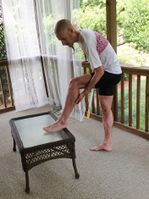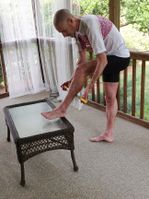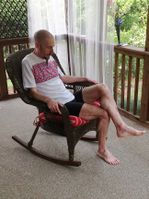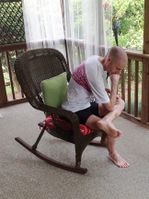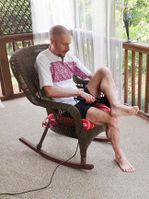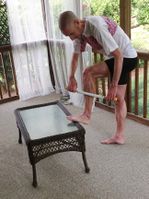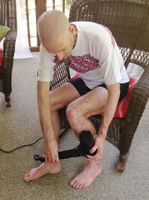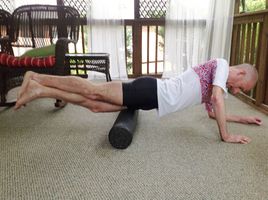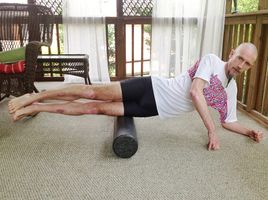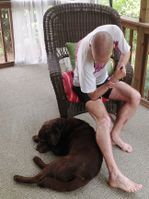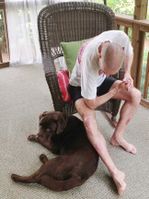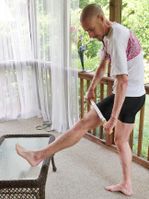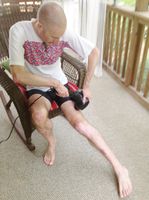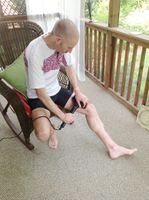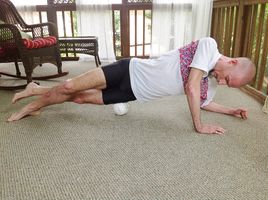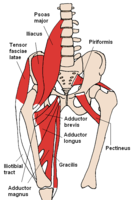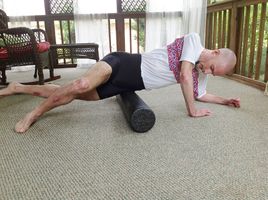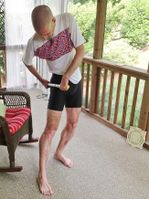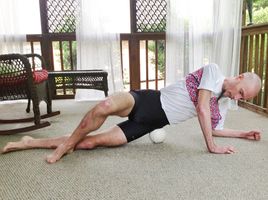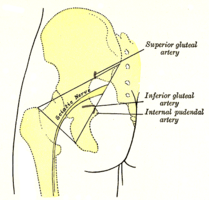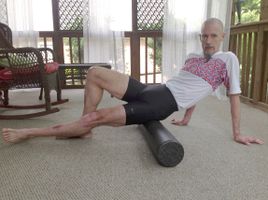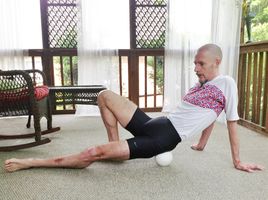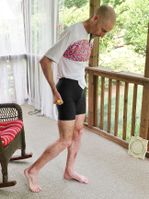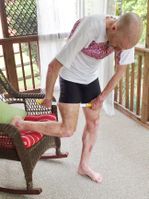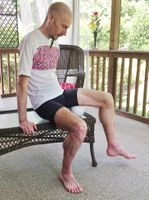Massage
Massage is a critical part of my training program, and I don't believe I could be successful without it. Massage can find Trigger Points, as they can be felt as hard knots and are painful to the touch. Massage can also treat the trigger points, by applying pressure to them until the muscle relaxes. The pressure can be continuous or repeated pulses. There are other treatments for trigger points, such as ultrasound, lasers, injections, etc., none of which I've tried.
Contents
1 Types of Massage
Massage can be provided by another person, or you can do self-massage. Self-massage can use your hands, or in limited situations, another body part, such as using a knee on the opposite calf. Using The Stick or Foam Roller is often more effective however.
2 Overview of Massage Techniques
These are my preferences on how to massage different parts of the body.
- Feet. I use a trigger wheel to massage the underside of my feet.
- Calves. The Stick works well on the calves, but requires a lot of force to get deep enough. Using your knee or elbow can get quite deep with good control, but can be awkward. The Thumper also works well on the calves.
- Hamstrings and hip adductors. The Stick works best here, but make sure the knee is bent and the foot supported so that the hamstring is relaxed.
- The quads. Use the Foam Roller, but take time to go deep enough to work the full muscle. The Stick can help, but it's hard to go deep enough. The elbow is great for going deep with lots of control. Be careful using only the Foam Roller, as this tends not to get to the VMO (see below for details).
- The Glutes. A softball is the best approach I've found for the glutes. I use a 16 inch circumference softball. (Thanks to Charles W for this tip!).
- Be careful near the Piriformis. The Piriformis lies over the sciatic nerve, so massage in this area can be quite painful. Problems in the Piriformis muscle can cause Piriformis Syndrome.
- ITB and Tensor Fascia Latae. This is a classic use of the Foam Roller, but remember to massage high enough to reach the TFL. I find The Stick works better on the TFL itself. See Iliotibial band syndrome for more details.
- Back. The Foam Roller can help stretch the back, and provides some level of massage.
- Hip Flexors. The hip flexors are always hard to massage as they are very deep. I have learned to lie on my back with my knees up and use my hands to massage my hip flexors. I have to relax the abdominal muscles and follow the hip flexor from the iliac (hip) crest down towards the spine. Raising my knee slightly will use the hip flexors so I can check that I am on the muscle. You really need someone with training to teach this technique to you, as you are getting to muscles near the spine from the front; there's lots of important bits you have to bypass to get there ;}
- Back. I have a Panasonic massage chair that does a good job on my back. Far from cheap, but it's proved its worth over the years I've had it. If I need more than the chair, I get my wife to use the Thumper or I use my Teeter Inversion Table. (I had Back Surgery so looking after my back is critical to me.)
3 Frequency of Massage
I am not aware of any studies around the optimal frequency or timing for massage. My personal approach is as follows:
- Once a day I will use the stick on all the muscles in my legs. This is primarily to check for any Trigger Points or other unexpected soreness, but it also functions as a minimal massage to keep things lose.
- I try to spend at least 1-2 hours a day doing preventative massage. I concentrate on using The Stick on my calves and the foam roller on my quads, but I also try to get to other muscle groups as well. This can be done while on the phone or watching TV, so it's not dedicated time, and I will often spend 3-4 hours in massage on a good day.
- If I have a specific problem, my approach is to massage little and often. I find that massaging a problem spot for 5-10 minutes several times a day seems to work better than one deeper session of massage. I'll back that up with Cryotherapy, often icing for 2-4 hour (this is instead of the massage above due to time limits).
This approach may not be optimal for you; I'm putting an unusual level of stress on my legs, and I find my quads need extensive massage to be effective.
4 Calf Massage
- Calf Massage
The Stick works remarkably well on the calves, and can detect muscular problems early. Roll the stick over the full length of the calf muscle, moving over the full width with successive strokes. Don’t use the stick on the front of the lower leg with the foot in this position as the muscle (Tibialis Anterior) will be under tension.
5 Quad Massage
- Quad Massage
My primary quad massage is the foam roller. Here you can see me massage the front of the quads, with both feet off the ground to put extra pressure on the muscle. If this is too deep, put the other foot on the ground (see notes and picture on the softball further down). This massages the Rectus femoris, which occupies the middle of the quad group close to the surface.
The foam roller also works well on the side of the quads, working the Vastus lateralis and the ITB.
One flaw with the foam roller is that it does not reach the Vastus Medialis Obliquus or VMO. This muscle may help keep the kneecap aligned, which in turn may be useful in treating knee pain. The elbow can reach this area quite well.
6 Hip Massage
The hip can be tricky to self-massage due to its location. This is quite a small area, between the hip joint and the crest of the pelvis (iliac crest), massaging primarily the Tensor fasciae latae. Below the hip joint is covered in quad massage and the buttock area is covered under glute massage. Hip massage may help with Knee Pain and Iliotibial band syndrome (ITBS).
- Hip Massage
7 Glute Massage
The glutes are the large muscles in the buttock area. Many people have heard of the gluteus maximus, but this area also includes the gluteus medius and gluteus minimus. Massaging these muscles may help with Knee Pain. Care must be taken when massaging this areas as the Sciatic nerve is below these muscles. Putting pressure on the Sciatic nerve is painful and a bad idea.
- Glute Massage
8 Hamstring and Adductor Massage
The hamstrings are made up of multiple muscles behind the thigh, and the adductors are the muscles on the inside of the thighs that pull the legs together.
- Hamstring and Adductor Massage
This is my preferred way of massaging the hamstrings, as it is easy to control the pressure. It’s important to bend the knee and support the foot so that the hamstrings are relaxed. If you have trouble relaxing your hamstrings, then gently pushing down on the foot in this position should help to relax them as a response to the quad contracting. Use The Stick gently as too much force can cause damage. The stick can move from the hamstrings at the back of the thigh to the adductors on the inside of the thigh quite easily.
It is possible to use the softball on the hamstrings. Stand next to a table or desk with your hip next to the table. Support your weight with the opposite foot on the floor. Lift the upper leg onto the table and hang the lower leg off the other edge of the table. So, you're halfway sitting on the table with one leg hanging over the side and the opposite leg still straight down on the floor. Take a softball, baseball, or lacrosse ball and place it under the upper leg that's resting on the table. (Thanks to Charles for this tip.)
